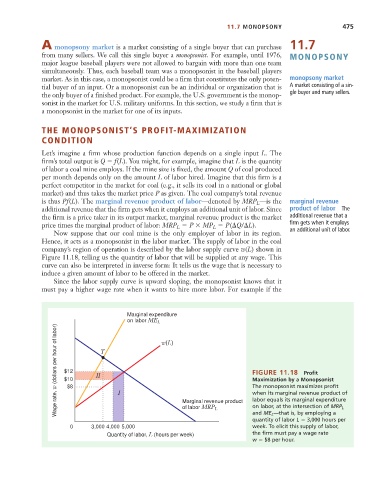Page 501 - Microeconomics, Fourth Edition
P. 501
c11monopolyandmonopsony.qxd 7/14/10 7:58 PM Page 475
11.7 MONOPSONY 475
A monopsony market is a market consisting of a single buyer that can purchase 11.7
from many sellers. We call this single buyer a monopsonist. For example, until 1976, MONOPSONY
major league baseball players were not allowed to bargain with more than one team
simultaneously. Thus, each baseball team was a monopsonist in the baseball players
market. As in this case, a monopsonist could be a firm that constitutes the only poten- monopsony market
tial buyer of an input. Or a monopsonist can be an individual or organization that is A market consisting of a sin-
gle buyer and many sellers.
the only buyer of a finished product. For example, the U.S. government is the monop-
sonist in the market for U.S. military uniforms. In this section, we study a firm that is
a monopsonist in the market for one of its inputs.
THE MONOPSONIST’S PROFIT-MAXIMIZATION
CONDITION
Let’s imagine a firm whose production function depends on a single input L. The
firm’s total output is Q f(L). You might, for example, imagine that L is the quantity
of labor a coal mine employs. If the mine size is fixed, the amount Q of coal produced
per month depends only on the amount L of labor hired. Imagine that this firm is a
perfect competitor in the market for coal (e.g., it sells its coal in a national or global
market) and thus takes the market price P as given. The coal company’s total revenue
is thus Pf(L). The marginal revenue product of labor—denoted by MRP —is the marginal revenue
L
additional revenue that the firm gets when it employs an additional unit of labor. Since product of labor The
the firm is a price taker in its output market, marginal revenue product is the market additional revenue that a
price times the marginal product of labor: MRP P MP P( Q/ L). firm gets when it employs
L
L
Now suppose that our coal mine is the only employer of labor in its region. an additional unit of labor.
Hence, it acts as a monopsonist in the labor market. The supply of labor in the coal
company’s region of operation is described by the labor supply curve w(L) shown in
Figure 11.18, telling us the quantity of labor that will be supplied at any wage. This
curve can also be interpreted in inverse form: It tells us the wage that is necessary to
induce a given amount of labor to be offered in the market.
Since the labor supply curve is upward sloping, the monopsonist knows that it
must pay a higher wage rate when it wants to hire more labor. For example if the
Marginal expenditure
on labor ME L w(L)
Wage rate, w (dollars per hour of labor) $12 II T I FIGURE 11.18 Profit
Maximization by a Monopsonist
$10
The monopsonist maximizes profit
$8
when its marginal revenue product of
labor equals its marginal expenditure
Marginal revenue product
of labor MRP
on labor, at the intersection of MRP L
L
and ME L —that is, by employing a
quantity of labor L 3,000 hours per
0 3,000 4,000 5,000 week. To elicit this supply of labor,
Quantity of labor, L (hours per week) the firm must pay a wage rate
w $8 per hour.

